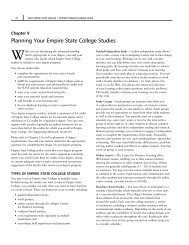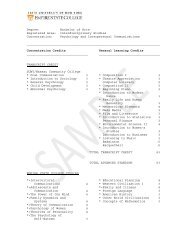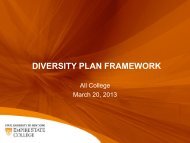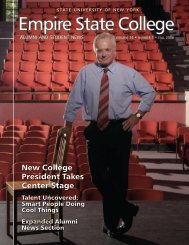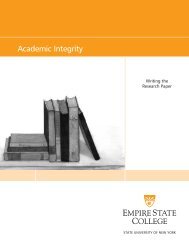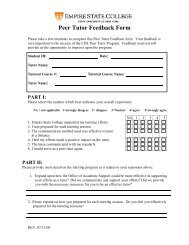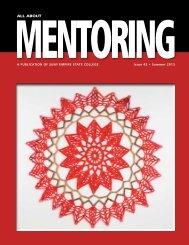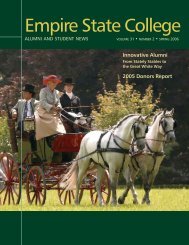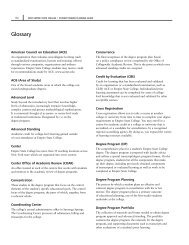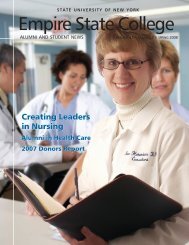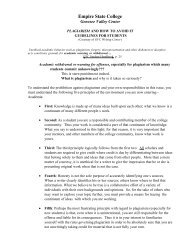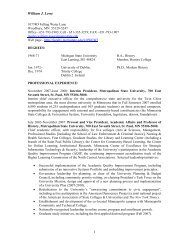Academic Plan 2011-2015 (PDF 524kB) - SUNY Empire State College
Academic Plan 2011-2015 (PDF 524kB) - SUNY Empire State College
Academic Plan 2011-2015 (PDF 524kB) - SUNY Empire State College
You also want an ePaper? Increase the reach of your titles
YUMPU automatically turns print PDFs into web optimized ePapers that Google loves.
<strong>SUNY</strong> <strong>Empire</strong> <strong>State</strong> <strong>College</strong>: <strong>Academic</strong> <strong>Plan</strong> <strong>2011</strong> - <strong>2015</strong> 5<strong>SUNY</strong> <strong>Empire</strong> <strong>State</strong> <strong>College</strong>: <strong>Academic</strong> <strong>Plan</strong> <strong>2011</strong> - <strong>2015</strong>PrefaceFollowing a process of consultation with faculty and staff throughout the college, the <strong>Academic</strong><strong>Plan</strong>ning Task Force (2010 - <strong>2011</strong>) is pleased to present <strong>SUNY</strong> <strong>Empire</strong> <strong>State</strong> <strong>College</strong>’s first academicplan. This plan is the result of many long hours of outreach, discussion, deliberation, and creativethinking by the members of the <strong>Academic</strong> <strong>Plan</strong>ning Task Force and the broader college community.We believe this plan can energize and inspire our academic community to approach the future withclarity, collegiality, and pride. We see this plan as an important step in helping to define and achieveaspirations for the college and for our students. In that spirit, we envision the academic plan to be aliving, evolving document, revisited and revised regularly to ensure its resilience and ongoing relevance.The overarching purpose of the plan is to organize and clarify an academic direction for the college.The task force was dedicated to developing a plan that is shaped by the input of faculty and staff;reaffirms the college’s commitments, values and traditions; facilitates the advancement of importantcollege and <strong>SUNY</strong> initiatives; and positions the college to thrive as it adapts to changes in the worldaround us. These factors are linked by a commitment to serve our students’ educational interestsand professional objectives, and this commitment, ultimately, is the plan’s cornerstone. The planenables the college to communicate its principles and educational emphases to external communities,including prospective students, and provides increased coherence and structure for decision makingregarding future program support. Moreover, the academic plan is intended to constitute a frameworkfor achieving a more robust interdisciplinary environment, a goal of considerable significance to ouracademic community.The plan seeks to clarify linkages between what the college has traditionally valued and the emergingneeds of our students. Thus, it represents an opportunity to celebrate the college’s history anddistinctiveness, while charting a course for our future.The <strong>Academic</strong> <strong>Plan</strong>ning Task Force wishes to acknowledge three important points. First, this plancannot – and is not intended to – address all issues and implications related to charting an academicdirection for the college. The academic plan can neither accommodate nor anticipate all the academicwork performed by the college or all the initiatives we may undertake in the future. Further, as thisis the first academic plan developed by the college, it represents a beginning rather than an endingpoint. Moreover, this plan is not intended to supersede the academic freedom of the faculty, norconstrict the purview of, or replace particular institutional structures, such as areas of study, throughwhich academic standards are developed and maintained. Rather, the purpose of the plan is to providecoherence of direction for the academic future of the college within a specific time frame. In thismanner, the plan is best viewed as a guide.Second, although there is a concerted effort to align the academic plan with major college initiativescurrently underway, not all new initiatives could be fully addressed. For example, as the open universityconcept matures, and as we undertake the process of updating our definition of “student success,” therelationship of these initiatives to an academic direction for the college can be considered more fully insubsequent iterations of the plan.




